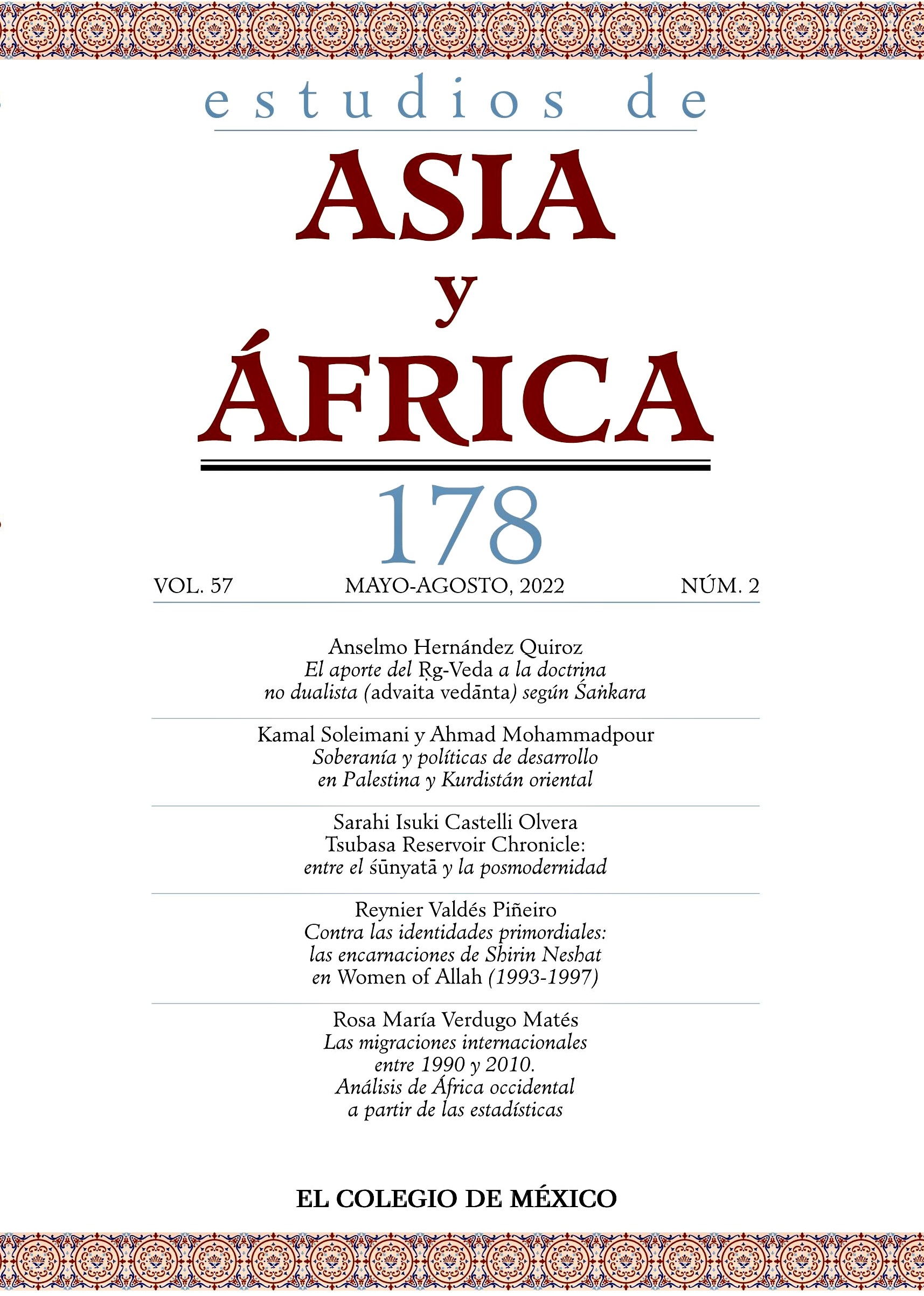Abstract
Śaṅkara accepts the Veda as the orthodox scriptural source for the inquiry into both dharma and brahman. Various studies have already analyzed the textual interrelationships woven by the author mainly around the upaniṣad in support of his non-dualistic doctrine (advaita vedānta), as well as the interpretation strategies that he employs. However, fewer works have explored the textual relationships in his commentaries on other canonical Vedic sources, such as the Ṛg-Veda. This article mainly focuses on identifying the Ṛg-Veda's contribution to the non-dualistic doctrine (advaita vedānta) according to Śaṅkara, initially by researching two connections between Śaṅkara’s commentary on the Brahma-Sūtra and the Ṛg-Veda.
References
Fuentes primarias
Apte, Vasudeo Mahadeo, trad. 1960. Brahma-sūtra Shānkara-Bhāshya: Bādarāyaṇā’s Brahma-sūtrās with Shaankarāchāryā’s Commentary. Bombay: Popular Book Depot.
Gambhirananda, Swami, trad. 1965. Brahma-Sūtra-Bhāṣya of Śrī Śaṅkarācārya. Calcuta: Advaita Ashrama.
Geldner, Karl Friedrich, trad. 1951. Der Rig-Veda. Vol. 1. Cambridge: Harvard University Press.
Griffith, Ralph T. H., trad. 1963. The Hymns of the Rigveda. Vol. 1. Varanasi: The Chowkhamba Sanskrit Series Office.
Hirst, Jacqueline Suthren. 2004. “Images of Śaṃkara: Understanding the Other”. International Journal of Hindhu Studies 8 (1-3): 157-181. https://doi.org/10.1007/s11407-004-0007-x
Īśādidaśopaniṣadaḥ śāṅkarabhāṣyasametāḥ. 1978. Texto sánscrito de diez principales upaniṣad con el comentario de Śaṅkara. Delhi: Motilal Banarsidass.
Jamison, Stephanie W. y Joel P. Brereton, trads. 2014. The Rigveda: The Earliest Religious Poetry of India. Vol. 1. Nueva York: Oxford University Press.
Madhavananda, Swami, trad. 2004. The Bṛhadāraṇyaka Upaniṣad. (With the commentary of Śaṅkarācārya). Calcuta: Advaita Ashrama.
Müller, Max F., ed. 1966. Rig-Veda-Samhita: The Sacred Hymns of the Brahmans, Together with the Commentary of Sayanacharya. Vol. 2. Benarés: The Chowkhamba Sanskrit Series Office.
Olivelle, Patrick, trad. 1998. The Early Upaniṣads. Nueva York: Oxford University Press.
Raja, Kunhan, trad. 1956. Asya Vāmasya Hymn. (The Riddle of the Universe). Ṛgveda 1-164. Madrás: Ganesh.
Śaṅkara. 1910a. Brahmasutra Bhashya. Vol. 1 de The Works of Sri Sankaracharya. Srirangam: Sri Vani Vilas Press.
Śaṅkara. 1910b. Bhagavad-Gita Bhashya. Vol. 11 de The Works of Sri Sankaracharya. Srirangam: Sri Vani Vilas Press.
Sarup, Lakshman, trad. 2009. The Nighaṇṭu and the Nirukta of Śrī Yāskācārya. Delhi: Motilal Banarsidass.
Thomson, Karen y Jonathan Slocum. 2021. The Rigveda: Metrically Restored Text. Texto editado en sánscrito. www.utexas.edu/cola/centers/lrc/RV/RV00.html
Fuentes secundarias
Deussen, Paul. 1912. The System of the Vedânta According to Bâdarâyana’s Brahma-Sûtras and Ҫaṅkara’s Commentary Thereon Set Forth as a Compendium of the Dogmatics of Brahmanism from the Standpoint of Ҫaṅkara. Traducido por Charles Johnston. Chicago: The Open Court Publishing Company.
Deutsch, Eliot. 1969. Advaita Vedānta: A Philosophical Reconstruction. Honolulu: East-West Center Press.
Doniger O’Flaherty, Wendy. 1981. The Rig Veda: An Anthology. Harmondsworth: Penguin.
Figueroa Castro, Óscar. 2013. “El arte de la interpretación en la India sánscrita: orígenes y desarrollo”. Nova Tellvs, 31 (1): 9-34. https://repositorio.unam.mx/contenidos/21733
Halbfass, Wilhelm. 1991. Tradition and Reflection: Explorations in Indian Thought. Albany: State University of New York Press.
Hernández Quiroz, Anselmo. 2016. “La realización divina sugerida por Vāmadeva: un estudio sobre la tradición exegética védica y vedānta de los himnos 4.26 y 4.27 del Ṛg-Veda”. Estudios de Asia y África 51 (3): 531-570. https://doi.org/10.24201/eaa.v51i3.2241
Hernández Quiroz, Anselmo. 2020. “Acerca del referente último del R̥g Veda”. Estudios de Asia y África 55 (1): 43-78. https://doi.org/10.24201/eaa.v55i1.2579
Hirst, Jacqueline Suthren. 1996. “Strategies of Interpretation: Śaṃkara’s Commentary on Bṛhadāraṇyakopaniṣad”. Journal of the American Oriental Society 116 (1): 58-75. https://doi.org/10.2307/606372
Isayeva, Natalia. 1993. Shankara and Indian Philosophy. Albany: State University of New York Press.
Knipe, David M. 1967. “The Heroic Theft: Myths from Ṛgveda IV and the Ancient Near East”. History of Religions 6 (4): 328-360. https://doi.org/10.1086/462550
Malinar, Angelika. 2014. “‘Following one’s desire’ (kāmacāra): On a Characterisation of Freedom in Vedic Literature and the Mahābhārata”. Asiatische Studien – Études Asiatiques 68 (3): 757-782. https://doi.org/10.1515/asia-2014-0058
Nakamura, Hajime. 1962. “Conflict between Traditionalism and Rationalism: A Problem with Śanṁkara”. Philosophy East and West 12 (2): 153-161. https://doi.org/10.2307/1397394
Nakamura, Hajime. 1983. A History of Early Vedānta Philosophy. Vol. 1. Traducido por Trevor Leggett. Delhi: Motilal Banarsidass.
Pandey, Sangam Lal. 1983. Pre-Śaṁkara Advaita Philosophy. Allahabad: Darshan Peeth.S
Uskokov, Aleksandar. 2018a. “Deciphering the Hidden Meaning: Scripture and the Hermeneutics of Liberation in Early Advaita Vedānta”. Tesis de doctorado. Universidad de Chicago.
Uskokov, Aleksandar. 2018b. “The Long and Short of It: Mahā-vākya from Mīmāṁsā to Jīva Gosvāmin, from the Veda to the Bhāgavata”. The Journal of Hindu Studies, 11 (1): 38-52. https://doi.org/10.1093/jhs/hiy013
Venkatarama Iyer, M. K. 1964. Advaita Vedānta, According to Shaṁkara. Nueva York: Asia Publishing House.
This work is licensed under a Creative Commons Attribution-NonCommercial-NoDerivatives 4.0 International License
Copyright 2022 Estudios de Asia y África



